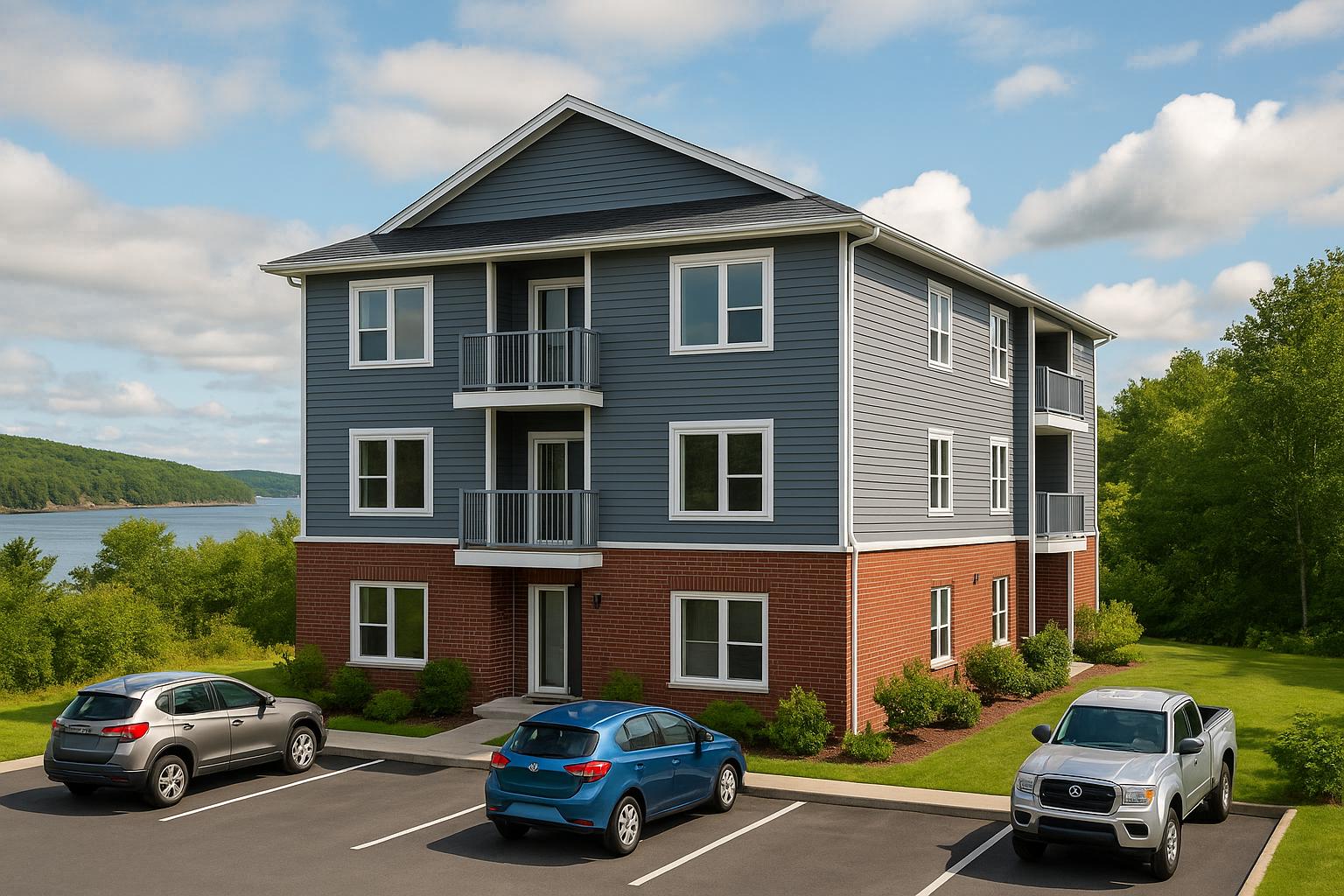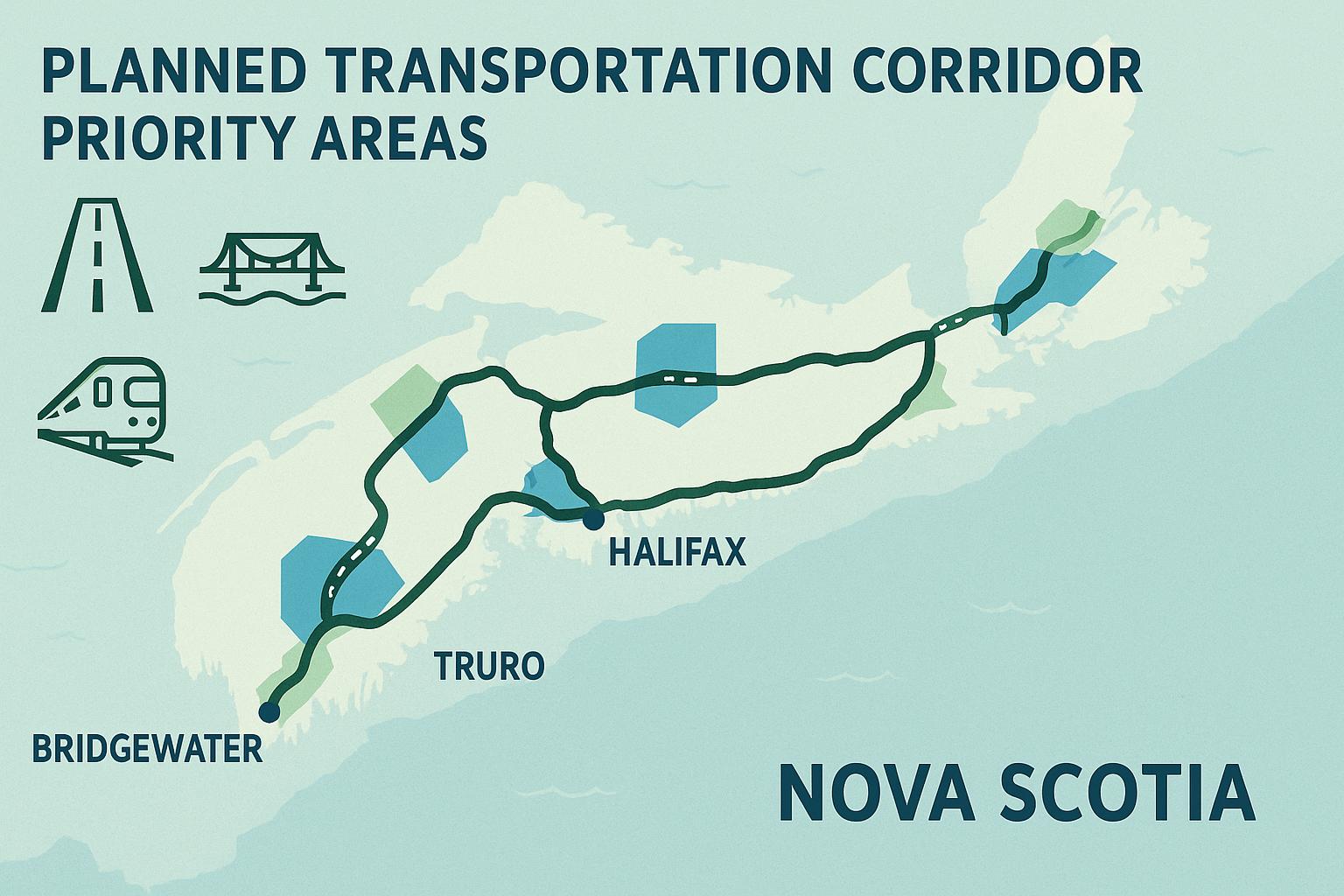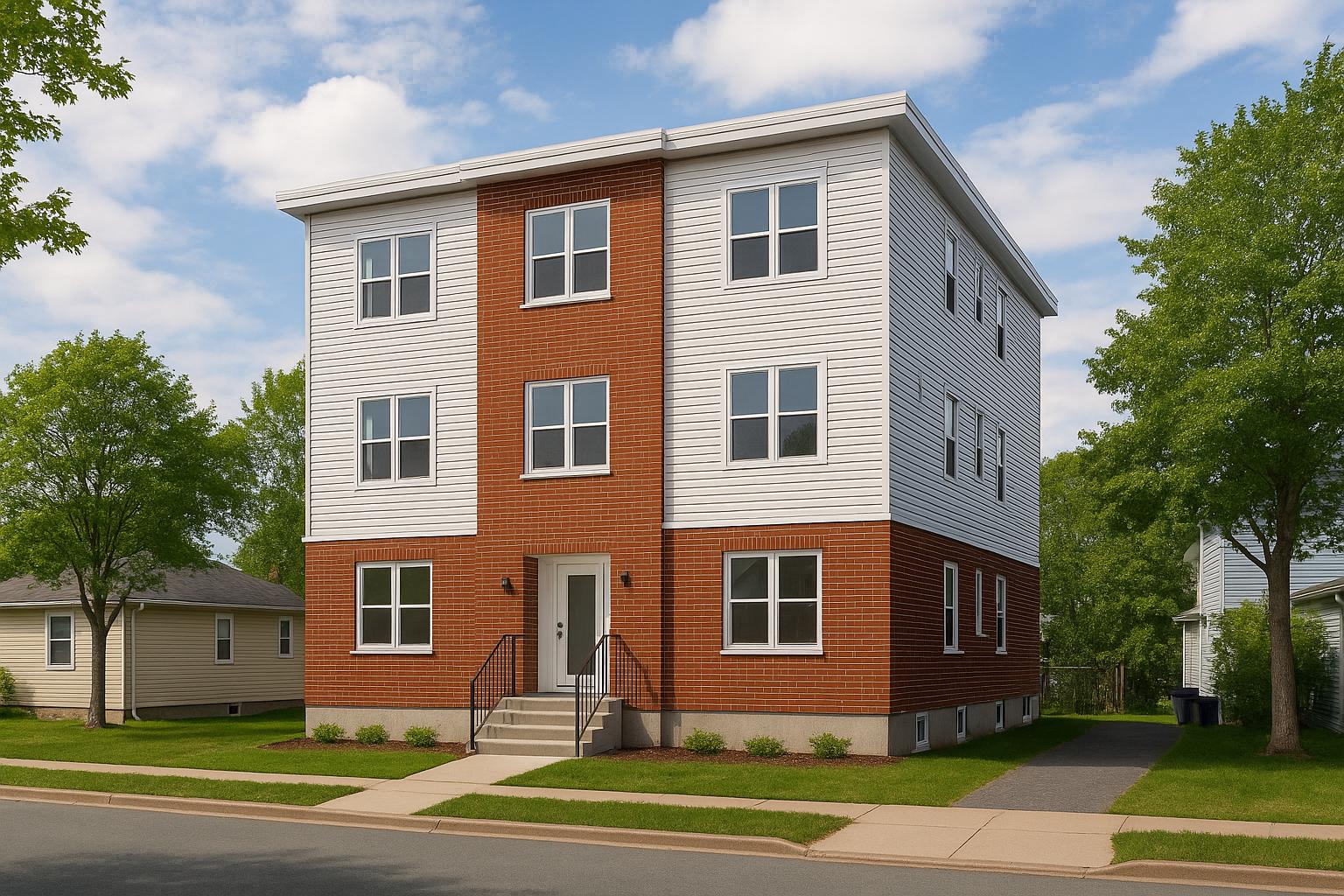Halifax’s ER-3 zoning is reshaping residential development by allowing medium-density housing like townhouses and row houses. This zoning bridges the gap between single-family homes and large apartment buildings, offering up to eight units per lot with flexible design options. Recent updates simplify permitting, relax parking requirements, and streamline construction processes, making it easier for property owners to generate rental income while meeting housing demand. Key regulations include height limits, setbacks, and design standards to ensure neighbourhood compatibility.
Key Takeaways:
- ER-3 Zoning Overview: Allows up to 8 units per lot, including townhouses, duplexes, and small apartments.
- Design Standards: Emphasize distinct entrances, varied finishes, and outdoor spaces.
- Permitting Simplified: Streamlined processes and fewer parking requirements.
- Construction Costs: Fixed-price contracts start at $160,000 per unit, with a 6-month timeline.
- Rental Potential: Two-bedroom units can rent for $1,950–$2,100/month.
- Heritage Areas: Additional rules apply to maintain historical integrity.
ER-3 zoning offers an efficient way to address Halifax’s housing needs, balancing modern development with neighbourhood preservation.
HALIFAX Home Owners May Have Just Won THE LOTTERY : Halifax Proposed Zoning Changes January 2024
ER-3 Zoning Requirements and Design Standards
Understanding ER-3 zoning rules is key to developing townhouses that meet both legal requirements and aesthetic expectations. These standards are essential for property owners looking to create rental units that comply with regulations while enhancing the neighbourhood. They cover everything from lot limits and design approaches to heritage considerations, offering a comprehensive framework for planning.
Lot Coverage, Setbacks, and Height Limits
ER-3 zoning lays out clear boundaries for development, including rules on building footprint, setbacks, and height. These guidelines ensure that new builds fit seamlessly into the existing neighbourhood. Setbacks vary depending on where the building sits on the lot, with front and side setbacks designed to create a sense of harmony with neighbouring properties. Height restrictions are also in place to maintain the area's overall scale, though features like dormers may exceed these limits if approved. Parking requirements are addressed with some flexibility, particularly for properties close to transit corridors, making it easier to balance development with urban accessibility.
Design Guidelines for Multi-Unit Buildings
For townhouse developments with multiple units, additional design standards aim to promote neighbourhood compatibility and pedestrian-friendly environments. Long, unbroken facades are discouraged; instead, developers are encouraged to use features like material changes, recessed entrances, or varied rooflines to add visual appeal and a sense of scale. Each townhouse must have its own distinct entrance to emphasize individuality. To avoid monotony, material and colour guidelines call for a mix of finishes, ensuring that units next to each other remain visually distinct. Landscaping is also a key requirement, with both front and rear outdoor spaces contributing to a welcoming and well-integrated streetscape.
Heritage and Conservation Area Rules
In heritage districts, additional rules ensure that new developments respect the historical character of the area. These districts often require design reviews by heritage planners to ensure that new townhouses complement existing architectural styles. Developers must use traditional materials and adhere to proportional designs that align with the area's established aesthetic. Demolition of heritage properties is often restricted, with adaptive reuse options encouraged as an alternative. For properties near heritage sites, developers must consider elements like sight lines, scale, and overall design to preserve views and historical integrity. In some cases, archaeological assessments may be required before construction begins.
While these heritage regulations add complexity, they don’t prevent townhouse development. Instead, they encourage thoughtful planning and early collaboration with heritage planning staff. For properties outside heritage districts, there is greater design flexibility, but the core ER-3 standards still ensure that developments are well-integrated into the community.
Benefits of Building Townhouses Under ER-3 Zoning
ER-3 zoning allows for up to eight units per lot - whether that's townhouses, duplexes, or small apartment buildings. This maximizes land use and helps distribute fixed costs, which can lead to better rental returns. Let’s break down how this increased density can boost rental income.
Higher Density and Rental Income
With the ability to build more units on a single lot, property owners can spread fixed costs like land acquisition, permits, and utilities across multiple rental spaces, improving their return on investment (ROI). ER-3 zoning also provides design flexibility, enabling property owners to tailor their projects to meet both financial goals and community preferences. This adaptability makes it easier to create developments that are both profitable and aligned with local needs.
Addressing Halifax's Missing Middle Housing
ER-3 zoning plays a key role in tackling Halifax's "missing middle housing" issue. Townhouses and other multi-unit developments offer family-friendly rental options that fill the gap between single-family homes and larger apartment complexes. These projects provide more space and a neighbourhood-scale feel, meeting the needs of residents who want something in between. By doing so, ER-3 developments can contribute to a more balanced housing supply and foster long-term community stability.
ER-3 vs. Older Zoning Models
The shift from traditional zoning to ER-3 opens up new opportunities for property owners. Here's how it compares:
| Zoning Type | Maximum Units | Building Types |
|---|---|---|
| ER-1 (Former) | 1 unit | Single-family homes |
| ER-3 (Current) | Up to 8 units | Townhouses, duplexes, small apartment buildings, condos |
Unlike older zoning rules that limited lots to single-unit homes, ER-3 zoning unlocks the potential for multi-unit developments. This change allows property owners to make better use of their land and increase its overall value.
How to Build Townhouses Under ER-3 Zoning
Building townhouses under ER-3 zoning in Halifax requires careful planning, a clear understanding of municipal regulations, and a team experienced in multi-unit residential projects. From securing permits to selecting the right builder, every step must be handled thoughtfully to avoid delays and unexpected costs.
Site Assessment and Design Planning
Start by confirming that your lot meets ER-3 zoning requirements. This includes reviewing lot coverage limits, setback rules, and height restrictions specific to your location. A detailed site assessment will help ensure your project aligns with these standards while maximizing density and rental potential.
When designing the townhouses, focus on creating attractive, marketable units. Two-bedroom townhouses are a popular choice, with tenants typically paying between $1,950 and $2,100 per month for high-quality accommodations. To appeal to renters and reduce operating costs, consider integrating features like ductless heat pumps, triple-pane windows, and engineered hardwood flooring.
If you're aiming for CMHC MLI Select compliance, be prepared for higher upfront costs - ranging from approximately $160,000 to $200,000 per unit. However, the benefits include access to 95% financing, a 5% down payment, and a 50-year amortization period, which can significantly ease long-term financial pressures.
Once the design is finalized, the next step is securing the necessary permits to move forward with construction.
Getting Permits and Approvals
Navigating Halifax's permitting process requires attention to detail. You'll need to obtain several permits, including development and building permits, as well as Right-of-Way permits (like DEV-ROW and TPW-ROW). Additionally, you'll need water, wastewater, and stormwater permits before breaking ground.
To meet Halifax Regional Municipality (HRM) requirements, contractors must hold certificates of insurance that name HRM as an additional insured party. The policy must include at least $2,000,000 in general commercial liability coverage [1]. Coordinating these permits efficiently is critical to keeping your project on schedule.
Choosing the Right Builder for Multi-Unit Projects
Once permits are in place, selecting the right builder becomes your top priority. Look for a contractor with proven experience in multi-unit projects and a deep understanding of Halifax's building environment. An integrated design-build approach can streamline the process by combining architecture, engineering, and construction under one team, helping to minimize coordination issues and budget overruns.
Key qualifications to look for include a strong track record of completed projects and transparent, upfront pricing with no hidden fees. Fixed-price contracts are especially useful for locking in costs and ensuring timely delivery, with financial penalties for delays.
To guarantee quality, work with builders who schedule multiple inspections by Professional Engineers and allow for final inspections by an owner-selected expert. Regular updates, such as daily progress photos and ongoing communication with a dedicated project manager, can also help keep the project on track.
Finally, ensure your builder provides comprehensive warranties. Typical coverage includes a one-year bumper-to-bumper warranty and a seven-year limited liability warranty, offering valuable peace of mind after construction is complete.
Common Problems and Solutions in Townhouse Development
Navigating townhouse development within Halifax's ER-3 framework can be a lucrative venture, but it’s not without its hurdles. Many property owners encounter challenges that can quickly escalate in cost and complexity. Being aware of these common issues - and how to address them - can make all the difference when embarking on a multi-unit development project in Halifax.
Common Problems in Multi-Unit Construction
Developing townhouses often comes with a host of challenges. These include poor coordination among teams, budget overruns that can range from 30% to 60%, lengthy delays that push back rental income opportunities, and disputes over quality control after construction is finished.
A typical project involves architects, engineers, general contractors, subcontractors, and various specialists, all of whom often operate independently. When communication breaks down between these groups, delays can snowball, leading to missed deadlines and lost revenue.
Quality control is another frequent issue. With multiple contractors working on different aspects of the build, oversight can become fragmented. This often results in property owners discovering defects after completion, sparking warranty disputes and disagreements over who is responsible for repairs.
Solutions Through Integrated Design-Build
One effective way to tackle these problems is by adopting an integrated design-build approach. This method brings all construction professionals - architects, engineers, and builders - onto a single, unified team, ensuring smoother communication and accountability from start to finish. By eliminating the fragmented nature of traditional construction, this approach minimizes delays and cost overruns.
| Traditional Fragmented Construction | Integrated Design-Build |
|---|---|
| Multiple contractors with separate responsibilities | Single team with unified accountability |
| Budget overruns of 30-60% | Fixed-price contracts with no surprises |
| Delays of 8-18+ months | Completion guaranteed in just 6 months |
| Accountability disputes for construction issues | One team responsible for all problems |
| Multiple, separate warranties | Single, comprehensive warranty |
| Communication breakdowns between teams | Streamlined planning and execution |
With this model, property owners work with one company that oversees every aspect of the project. This eliminates the common communication gaps that often lead to delays and unexpected expenses. If an issue arises, there’s no finger-pointing - one team is responsible for resolving it.
Time savings are another major benefit. Advanced planning and coordination can shrink construction timelines from the typical 12-18 months to just 6 months. This faster delivery allows property owners to start generating rental income much sooner, significantly boosting their return on investment.
Fixed-Price Contracts for Cost Certainty
For property owners concerned about budget overruns, fixed-price contracts offer a reliable solution. Unlike cost-plus contracts, where the final cost can balloon as the project progresses, fixed-price agreements lock in the total cost before construction begins.
Under this model, builders must provide detailed upfront pricing that accounts for every aspect of the project. Property owners have peace of mind knowing exactly what they’ll pay, with no hidden fees or unexpected charges.
Fixed-price contracts also often include timeline guarantees. Some builders even offer financial penalties - such as $1,000 per day - for delays, ensuring that property owners are compensated if the project runs late. This level of accountability is rarely achievable with traditional construction methods, where delays often lead to finger-pointing among contractors.
Additionally, professional inspections at key stages of the project, combined with comprehensive warranties, cover both immediate issues and long-term structural concerns. This gives property owners confidence that their investment is protected.
sbb-itb-16b8a48
Making the Most of ER-3 Zoning Opportunities
Halifax's ER-3 zoning presents a fantastic opportunity for property owners to boost rental income. This zoning framework simplifies the path to multi-unit development, opening up possibilities for townhouse projects that can yield impressive returns. Here’s how ER-3 zoning reshapes development strategies for property owners.
Key Points for Property Owners
ER-3 zoning allows for higher-density development compared to older residential zones. This means property owners can unlock their land's full earning potential by increasing the number of rental units and planning developments strategically.
The approval process for ER-3 projects is far more straightforward. With clear design guidelines and standardized requirements, property owners can navigate permitting with less hassle, keeping projects on track and within budget.
Construction plays a pivotal role in ER-3 projects. An integrated design-build approach offers fixed-price construction at $160,000 per unit, with a guaranteed six-month completion timeline. To ensure accountability, delays can result in financial penalties of up to $1,000 per day.
Delays in construction can be costly. For example, a fourplex project delayed by just one month could result in about $8,800 in lost rental income. This underscores the importance of sticking to reliable timelines.
Next Steps for Better ROI
To fully leverage the benefits of ER-3 zoning, start with a detailed site assessment. Evaluate your land’s development potential by reviewing factors like lot coverage, setbacks, and height restrictions. This will help you determine the maximum number of units your property can accommodate.
Selecting the right construction partner is equally important. Helio Urban Development, Nova Scotia’s only integrated design-build company, streamlines the process by bringing planners, architects, engineers, and construction crews together under one roof. Their approach aligns seamlessly with Halifax’s updated ER-3 standards, ensuring your project meets both regulatory and market expectations.
If financing is a priority, Helio offers a CMHC MLI Select construction option at $200,000 per unit. This option allows for 95% financing with as little as a 5% down payment, making it possible to build more units with the same capital while maintaining positive cash flow from the start.
For those looking to hit the ground running, the Premium Rental Ready Package is worth considering. For an extra $15,000 per unit, this package includes Energy Star appliances, smart home features, and furnishings, allowing you to start collecting rent immediately without the typical 60-day post-construction wait.
If your property is located within a 90-minute drive of Halifax, these opportunities are within reach. With a strong rental market, ER-3 zoning paired with an integrated construction approach offers a winning formula for generating steady rental income.
FAQs
How does ER-3 zoning help address Halifax's housing challenges compared to traditional zoning?
ER-3 Zoning in Halifax: A Solution for Housing Challenges
ER-3 zoning in Halifax is an important tool in tackling the city’s housing needs. It allows for higher-density projects, such as multi-unit townhouses with up to eight units. By enabling more efficient use of land, this zoning type gives property owners the chance to create additional rental units, addressing the increasing demand for diverse and affordable housing.
Unlike traditional single-family zoning, ER-3 zoning permits multiple rental units on a single lot. This not only helps ease housing shortages but also enhances the value of the property. It’s a forward-thinking approach that aligns with Halifax’s broader goals of boosting housing availability and promoting sustainable urban development.
What should I know about building townhouses in Halifax heritage areas under ER-3 zoning?
Building Townhouses in Halifax Heritage Areas: Key Considerations
When constructing townhouses in Halifax's heritage areas under ER-3 zoning, it's crucial to adhere to both zoning regulations and heritage conservation guidelines. ER-3 zoning typically permits buildings up to 11 metres in height (approximately 3 storeys). However, in heritage districts such as the Young Avenue Heritage Conservation District, additional considerations come into play. Designs must align with the historic character of the area and comply with heritage conservation policies.
To stay on the right track, ensure your townhouse design harmonizes with the surrounding architecture. Take the time to review local heritage regulations, as they can significantly influence your project. Thoughtful planning not only helps preserve the charm and character of these historic neighbourhoods but also allows you to make the most of density and rental income opportunities.
What are the benefits of using a design-build approach for developing townhouses under Halifax's ER-3 zoning?
The Advantages of a Design-Build Approach for Halifax's ER-3 Zoning
Using a design-build approach for townhouse projects in Halifax's ER-3 zoning can bring a host of benefits. By streamlining both the design and construction phases into a single, unified process, this method helps cut down on project timelines, keeps costs in check, and reduces risks that can arise from miscommunication or mismanagement.
One of the standout features of this approach is its single point of accountability. This makes it easier for property owners to navigate ER-3 zoning rules, helping them make the most of allowable density and, in turn, boost rental income potential. Plus, the design-build process ensures smoother coordination across all stages of development, leading to fewer delays and tighter control over expenses. For anyone pursuing multi-unit developments, this method offers a dependable way to achieve high-quality results while staying on schedule and within budget.



